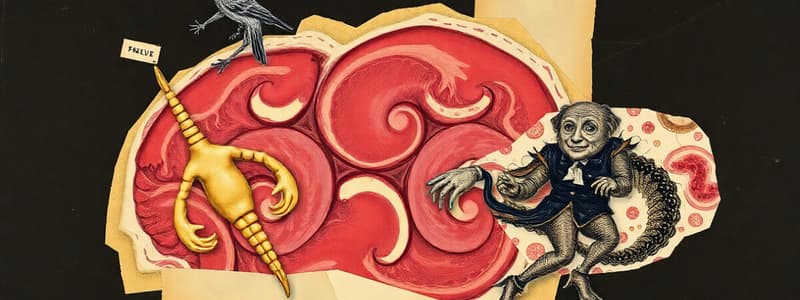Podcast
Questions and Answers
Tissues that need preservation will certainly dehydrate
Tissues that need preservation will certainly dehydrate
False (B)
Under-embalmed tissue can dehydrate slower than well-embalmed tissue
Under-embalmed tissue can dehydrate slower than well-embalmed tissue
False (B)
There will be more chance of leakage from an incision if you end at the "low-end" of the suture track
There will be more chance of leakage from an incision if you end at the "low-end" of the suture track
True (A)
It is easier to cosmetise up from a darker surface than from a lighter surface
It is easier to cosmetise up from a darker surface than from a lighter surface
Ascites is oedema of the thoracic cavity
Ascites is oedema of the thoracic cavity
Antemortem subcutaneous emphysema is tissue gas (gas gangrene) that affects the skin prior to death
Antemortem subcutaneous emphysema is tissue gas (gas gangrene) that affects the skin prior to death
The Sigmoid Colon can be found in the right inguinal region of the abdomen
The Sigmoid Colon can be found in the right inguinal region of the abdomen
Trocar guidelines include the brain
Trocar guidelines include the brain
The pancreas is considered to be a solid organ in cavity embalming
The pancreas is considered to be a solid organ in cavity embalming
The lungs are considered to be both a hollow organ and a solid organ in cavity embalming
The lungs are considered to be both a hollow organ and a solid organ in cavity embalming
For a hydro-aspirator to work properly and create an optimum level of suction there must be 40 to 50 PSI of water pressure.
For a hydro-aspirator to work properly and create an optimum level of suction there must be 40 to 50 PSI of water pressure.
PSI stands for 'pump suction inclination'.
PSI stands for 'pump suction inclination'.
Reaspiration may be required with cases of ascites.
Reaspiration may be required with cases of ascites.
Hydrocele is oedema of the brain
Hydrocele is oedema of the brain
To aspirate the brain an infant trocar needs to be inserted through the ethmoid bone to enter the cranial cavity.
To aspirate the brain an infant trocar needs to be inserted through the ethmoid bone to enter the cranial cavity.
To aspirate the contents of the stomach the trocar from the standard entry point needs to be directed superiorly towards the intersection of the seventh intercostal space and the left mid-axillary line.
To aspirate the contents of the stomach the trocar from the standard entry point needs to be directed superiorly towards the intersection of the seventh intercostal space and the left mid-axillary line.
The urinary bladder (when distended) is found in the epigastric region.
The urinary bladder (when distended) is found in the epigastric region.
The baseball suture is the preferred suture for embalming as it is very secure and literally 'air tight'.
The baseball suture is the preferred suture for embalming as it is very secure and literally 'air tight'.
Cachexia means general ill-health and malnutrition.
Cachexia means general ill-health and malnutrition.
When there is atrophy of the mandible it is recommended that the needle injector be used to close the mouth
When there is atrophy of the mandible it is recommended that the needle injector be used to close the mouth
It is best to use a mild arterial solution when embalming an infant.
It is best to use a mild arterial solution when embalming an infant.
Arteriosclerosis can lead to both decubitus ulcers and amputation of extremities
Arteriosclerosis can lead to both decubitus ulcers and amputation of extremities
Decubitus ulcers are the result of poor circulation.
Decubitus ulcers are the result of poor circulation.
Rapid injection and continuous drainage can cause dehydration
Rapid injection and continuous drainage can cause dehydration
With a ruptured aortic aneurysm it is normally necessary to carry out a multi-point injection.
With a ruptured aortic aneurysm it is normally necessary to carry out a multi-point injection.
A malignant neoplasm has limited potential for growth.
A malignant neoplasm has limited potential for growth.
Diabetes Mellitus can cause arteriosclerosis and degenerative changes in small blood vessels.
Diabetes Mellitus can cause arteriosclerosis and degenerative changes in small blood vessels.
It is preferable to permanently set the lips prior to arterial injection with cases that you know will not purge
It is preferable to permanently set the lips prior to arterial injection with cases that you know will not purge
When embalming infants it is advisable to use the pulsation option during injection.
When embalming infants it is advisable to use the pulsation option during injection.
Heparin causes the blood to thicken and coagulate.
Heparin causes the blood to thicken and coagulate.
An elevated environmental temperature will slow the rigor mortis cycle.
An elevated environmental temperature will slow the rigor mortis cycle.
Refrigeration will not stop decomposition
Refrigeration will not stop decomposition
Massaging should be avoided with cases in intense rigor mortis to prevent distension
Massaging should be avoided with cases in intense rigor mortis to prevent distension
When arterially injecting refrigerated cases the rate of flow must be kept low
When arterially injecting refrigerated cases the rate of flow must be kept low
It is possible to dehydrate a case by using too much humectant
It is possible to dehydrate a case by using too much humectant
All pathological discolourations occur after death
All pathological discolourations occur after death
Post mortem stain is caused by haemolysis
Post mortem stain is caused by haemolysis
Surface evaporation of moisture is the single most important post mortem cause of tissue dehydration
Surface evaporation of moisture is the single most important post mortem cause of tissue dehydration
Flashcards
Decubitus ulcers cause
Decubitus ulcers cause
Poor circulation and pressure are responsible for decubitus ulcers, or bedsores.
Rapid injection & drainage cause
Rapid injection & drainage cause
Rapid injection and continuous drainage can lead to dehydration.
Ruptured aortic aneurysm injection
Ruptured aortic aneurysm injection
A ruptured aortic aneurysm typically requires multiple injection points.
Malignant neoplasm growth
Malignant neoplasm growth
Signup and view all the flashcards
Diabetes and blood vessels
Diabetes and blood vessels
Signup and view all the flashcards
Lip setting before injection
Lip setting before injection
Signup and view all the flashcards
Infant embalming injection
Infant embalming injection
Signup and view all the flashcards
Heparin's effect on blood
Heparin's effect on blood
Signup and view all the flashcards
Temperature & rigor mortis
Temperature & rigor mortis
Signup and view all the flashcards
Refrigeration stopping decomposition
Refrigeration stopping decomposition
Signup and view all the flashcards
Rigor mortis & massaging
Rigor mortis & massaging
Signup and view all the flashcards
Refrigerated case injection rate
Refrigerated case injection rate
Signup and view all the flashcards
Humectant and dehydration
Humectant and dehydration
Signup and view all the flashcards
Pathological discolouration timing
Pathological discolouration timing
Signup and view all the flashcards
Post-mortem stain cause
Post-mortem stain cause
Signup and view all the flashcards
Tissue dehydration major cause
Tissue dehydration major cause
Signup and view all the flashcards
Study Notes
True or False Questions
- Tissues needing preservation will dehydrate.
- Under-embalmed tissue dehydrates slower than well-embalmed tissue.
- Leakage from an incision is more likely if ending at the lower end of the suture track.
- Cosmetically, it's easier to improve a darker surface than a lighter one.
- Ascites is fluid build-up in the chest cavity (not the thoracic cavity).
- Antemortem subcutaneous emphysema is gas in tissues before death.
- The sigmoid colon is in the lower right abdomen (not right inguinal region).
- Trocar guidelines do not include the brain.
- The pancreas is considered a solid organ during embalming.
- The lungs are both hollow and solid organs during embalming.
- 40-50 PSI of water pressure is needed for a hydro-aspirator to work optimally.
- PSI stands for pump suction inclination (not pressure).
- Re-aspiration might be needed in cases with ascites.
- Hydrocele is fluid build-up in the scrotum or peritoneum (not in the brain).
- Aspiration of an infant's brain requires inserting a trocar through the ethmoid bone to reach the cranium.
- Aspiration of stomach contents requires directing the trocar superiorly towards the intersection of the seventh intercostal space and left mid-axillary line.
- The bladder is in the epigastric region when distended.
- Baseball suture is a secure, airtight embalming suture.
- Cachexia is general ill-health and malnutrition.
- When the mandible atrophies, a needle injector may be used to close the mouth.
- A mild arterial solution is best for embalming infants.
Additional Embalming Information
- Arteriosclerosis can cause decubitus ulcers and amputations due to poor circulation.
- Rapid injection and continuous drainage lead to dehydration.
- A ruptured aortic aneurysm often requires multi-point injection.
- Malignant neoplasms have limited growth potential.
- Diabetes can cause arteriosclerosis and damage small blood vessels.
- Lips are best set permanently before artery injection in cases that won't purge.
- Infants are best embalmed using the pulsation injection method.
- Heparin causes blood to thicken and coagulate.
- Elevated temperatures slow the rigor mortis process.
- Massaging should be avoided during intense rigor mortis to prevent distension.
- Refrigerated cases require slow arterial injection rates.
- Too much humectant can dehydrate a body.
- Pathological discoloration occurs after death.
- Post-mortem staining is caused by haemolysis.
- Surface moisture evaporation is the most important post-mortem dry-out factor.
Studying That Suits You
Use AI to generate personalized quizzes and flashcards to suit your learning preferences.




